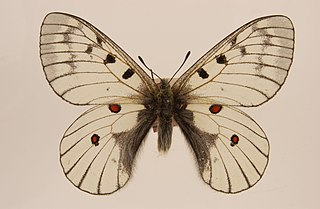
The clouded Apollo is a butterfly species of the family of swallowtail butterflies (Papilionidae) found in the Palearctic realm.

Parnassius delphius, the banded Apollo, is a high-altitude butterfly which is found in Central Asia. It is a member of the genus Parnassius of the swallowtail family, Papilionidae.

Parnassius acco, the varnished Apollo, is a high-altitude butterfly found in Asia. It is a member of the snow Apollo genus Parnassius of the swallowtail family, Papilionidae.

Parnassius actius, also known as the scarce red apollo, is a high-altitude butterfly found in Central Asia. It is a member of the snow Apollo genus (Parnassius) of the swallowtail family (Papilionidae).

Parnassius glacialis, the glacial Apollo or Japanese clouded Apollo, is a high-altitude butterfly found in Japan, eastern China, and Korea. It is a member of the snow Apollo genus (Parnassius) of the swallowtail family (Papilionidae).

Parnassius apollonius is a member of the snow Apollo genus Parnassius of the swallowtail family, Papilionidae. It is found in central and south Kazakhstan, the south Altai, Saur, Tarbagatai, Dzhungarsky Alatau, Tian-Shan, Ghissar-Darvaz, the Pamirs-Alai and west China.

Parnassius clodius is a white butterfly which is found in the United States and Canada. It is a member of the snow Apollo genus (Parnassius) of the swallowtail family (Papilionidae). Its elevation range is 0–7,000 ft (0–2,134 m).

Parnassius ariadne is a high altitude butterfly which is found in Central Asia. It is a member of the snow Apollo genus (Parnassius) of the swallowtail family (Papilionidae).

Parnassius eversmanni, or Eversmann's parnassian, is a high-altitude butterfly which is found in eastern Russia, Mongolia, Japan, Alaska, and the Yukon. It is a member of the snow Apollo genus (Parnassius) of the swallowtail family, Papilionidae. The species was named to honour Eduard Friedrich Eversmann.

Parnassius bremeri is a high altitude butterfly which is found in Russia, Korea and China. It is a member of the snow Apollo genus (Parnassius) of the swallowtail family (Papilionidae). Over its vast range, the species varies widely in morphology and many subspecies have been described.

Parnassius cephalus is a high altitude butterfly which is found in Tibet and west China. It is a member of the snow Apollo genus (Parnassius) of the swallowtail family, Papilionidae. The species was first described by Grigory Grum-Grshimailo in 1891.

Parnassius nordmanni is a high altitude butterfly which is found the Caucasus. It is a member of the snow Apollo genus (Parnassius) of the swallowtail family, Papilionidae. The larva feeds on Corydalis species including C. alpestris, C. conorhiza and C. emanueli.

Parnassius tenedius, the tenedius Apollo, is an east Palearctic member of the snow Apollo genus (Parnassius) of the swallowtail family (Papilionidae). Populations range from Siberia and the Far East of Russia to the western Chukchi Peninsula, Mongolia and north China. The larva feeds on Corydalis species. In the northern part of its range it is a low altitude butterfly; further south it is montane.

Parnassius orleans is a high altitude butterfly which is found in Mongolia, western China and Tibet. It is a member of the snow Apollo genus (Parnassius) of the swallowtail family, Papilionidae. It was named after Prince Henri of Orléans who discovered it.

Parnassius szechenyii is a high-altitude butterfly which is found in western China. It is a member of the snow Apollo genus (Parnassius) of the swallowtail family, Papilionidae. The species was first described by Imre Frivaldszky in 1886.

Parnassius cardinal, the cardinal Apollo, is a high-altitude butterfly which is found in north Afghanistan and Tajikistan. It is a member of the snow Apollo genus (Parnassius) of the swallowtail family (Papilionidae). The species was first described by Grigory Grum-Grshimailo in 1887.

Parnassius felderi, the Felder's Apollo, is a high-altitude butterfly which is found in Amur, Ussuri and China, North Korea and Japan. It is a member of the snow Apollo genus (Parnassius) of the swallowtail family, (Papilionidae).
Parnassius przewalskii is a high-altitude butterfly which is found in Tibet and west China. It is a member of the snow Apollo genus (Parnassius) of the swallowtail family (Papilionidae).

Parnassius staudingeri is a high-altitude butterfly which is found over a vast area - Pamirs, Altay Mountains, Hindu Kush, Karakorum and west Kuen-Lun.

Erebia maurisius is a butterfly found in the East Palearctic that belongs to the browns family.



















